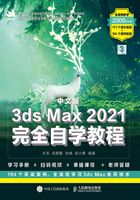
1.8 综合训练营
通过本章的学习,相信读者已经能简单地操作3ds Max的相关功能了。下面通过两个综合训练复习本章所学的内容。
重点综合训练:玩具小火车

扫码观看视频
场景文件 场景文件>CH01>08.max
实例文件 实例文件>CH01>综合训练:玩具小火车.max
难易程度 ★☆☆☆☆
技术掌握 练习移动、旋转和复制对象
本案例是用所提供的模型拼合一个玩具小火车,需要用到之前学过的移动、旋转和复制对象的方法。案例效果如图1-212所示。

图1-212
 打开本书学习资源中的“场景文件>CH01>08.max”文件,如图1-213所示。场景中提供了两个大小不同的长方体模型和一个圆柱体模型,需要将其复制后拼合为一个小火车模型。
打开本书学习资源中的“场景文件>CH01>08.max”文件,如图1-213所示。场景中提供了两个大小不同的长方体模型和一个圆柱体模型,需要将其复制后拼合为一个小火车模型。
 选中圆柱体模型,然后使用“选择并旋转”工具
选中圆柱体模型,然后使用“选择并旋转”工具 将其旋转90°,作为小火车的车轮,放在大长方体模型的侧面,效果如图1-214所示。
将其旋转90°,作为小火车的车轮,放在大长方体模型的侧面,效果如图1-214所示。

图1-213

图1-214
 选中圆柱体模型,然后按住Shift键并使用“选择并移动”工具
选中圆柱体模型,然后按住Shift键并使用“选择并移动”工具 沿着y轴向左拖曳鼠标,复制一个圆柱体模型,效果如图1-215所示。
沿着y轴向左拖曳鼠标,复制一个圆柱体模型,效果如图1-215所示。
 选中两个圆柱体模型,然后复制到大长方体模型的另一侧,效果如图1-216所示。这样就做好了小火车的车轮。
选中两个圆柱体模型,然后复制到大长方体模型的另一侧,效果如图1-216所示。这样就做好了小火车的车轮。
 将小长方体模型移动到大长方体模型的上方,效果如图1-217所示。
将小长方体模型移动到大长方体模型的上方,效果如图1-217所示。
 将圆柱体模型复制一个并旋转90°,然后放在大长方体模型的上方,效果如图1-218所示。
将圆柱体模型复制一个并旋转90°,然后放在大长方体模型的上方,效果如图1-218所示。

图1-215

图1-216

图1-217

图1-218
 使用“选择并均匀缩放”工具
使用“选择并均匀缩放”工具 将上一步复制的圆柱体模型沿y轴拉长,与小长方体模型相接,效果如图1-219所示。
将上一步复制的圆柱体模型沿y轴拉长,与小长方体模型相接,效果如图1-219所示。
 将小长方体模型向上复制一个,然后沿着z轴将其缩小,效果如图1-220所示。
将小长方体模型向上复制一个,然后沿着z轴将其缩小,效果如图1-220所示。
 继续使用“选择并均匀缩放”工具
继续使用“选择并均匀缩放”工具 沿着y轴将刚才缩小的长方体模型拉长,效果如图1-221所示。
沿着y轴将刚才缩小的长方体模型拉长,效果如图1-221所示。

图1-219

图1-220

图1-221
 使用“选择并移动”工具
使用“选择并移动”工具 将拉长的长方体模型与下方的长方体模型对齐,效果如图1-222所示。
将拉长的长方体模型与下方的长方体模型对齐,效果如图1-222所示。
 将大长方体模型和4个圆柱体轮子向后整体复制两个,效果如图1-223所示。
将大长方体模型和4个圆柱体轮子向后整体复制两个,效果如图1-223所示。
 选中图1-224所示的小长方体模型,然后向后复制一个,效果如图1-225所示。
选中图1-224所示的小长方体模型,然后向后复制一个,效果如图1-225所示。

图1-222

图1-223

图1-224

图1-225
 使用“选择并均匀缩放”工具
使用“选择并均匀缩放”工具 将复制的小长方体模型压扁一些,效果如图1-226所示。
将复制的小长方体模型压扁一些,效果如图1-226所示。
 将调整后的小长方体模型复制3个,效果如图1-227所示。
将调整后的小长方体模型复制3个,效果如图1-227所示。
 将调整后的小长方体模型向后继续复制一个,效果如图1-228所示。
将调整后的小长方体模型向后继续复制一个,效果如图1-228所示。
 使用“选择并均匀缩放”工具
使用“选择并均匀缩放”工具 将上一步复制的小长方体模型拉长一些,效果如图1-229所示。
将上一步复制的小长方体模型拉长一些,效果如图1-229所示。

图1-226

图1-227

图1-228

图1-229
 将调整后的长方体模型向上复制3个,效果如图1-230所示。
将调整后的长方体模型向上复制3个,效果如图1-230所示。
 调整小火车模型的细节,小火车模型的最终效果如图1-231所示。
调整小火车模型的细节,小火车模型的最终效果如图1-231所示。
知识链接:局部缩放的方法
相信读者在制作案例时会发现,缩放后的长方体模型的圆角会变得不均匀,这是因为使用“选择并均匀缩放”工具 缩放长方体模型时,圆角也会跟随缩放。如果想保持圆角大小不变并改变长方体模型的尺寸,读者就需要学习“2.7 编辑多边形对象”的相关内容。
缩放长方体模型时,圆角也会跟随缩放。如果想保持圆角大小不变并改变长方体模型的尺寸,读者就需要学习“2.7 编辑多边形对象”的相关内容。

图1-230

图1-231
重点综合训练:照片墙

扫码观看视频
场景文件 场景文件>CH01>09.max
实例文件 实例文件>CH01>综合训练:照片墙.max
难易程度 ★☆☆☆☆
技术掌握 练习移动对象和对齐工具
本案例是将大小不等的照片模型拼合为一个照片墙效果。案例效果如图1-232所示。
 打开本书学习资源中的“场景文件>CH01>09.max”文件,如图1-233所示。场景中包含大小两种照片模型。
打开本书学习资源中的“场景文件>CH01>09.max”文件,如图1-233所示。场景中包含大小两种照片模型。

图1-232

图1-233
 切换到前视图,选中左侧的大幅海浪照片模型,然后使用“选择并移动”工具
切换到前视图,选中左侧的大幅海浪照片模型,然后使用“选择并移动”工具 将其移动到画面左下角的位置,如图1-234所示。
将其移动到画面左下角的位置,如图1-234所示。
 选中自行车照片模型,然后使用“选择并移动”工具
选中自行车照片模型,然后使用“选择并移动”工具 将其移动到大幅海浪照片模型的右上方,如图1-235所示。
将其移动到大幅海浪照片模型的右上方,如图1-235所示。
 选中右侧的道路照片模型,然后将其移动到自行车照片模型的右侧,如图1-236所示。
选中右侧的道路照片模型,然后将其移动到自行车照片模型的右侧,如图1-236所示。

图1-234

图1-235

图1-236
 保持道路照片模型的选中状态,单击“对齐”按钮
保持道路照片模型的选中状态,单击“对齐”按钮 后单击左侧的自行车照片模型,在弹出的“对齐当前选择”对话框中勾选“Y位置”选项,设置“当前对象”和“目标对象”都为“最大”,如图1-237所示。这时两幅照片模型将呈现上方对齐效果,如图1-238所示。
后单击左侧的自行车照片模型,在弹出的“对齐当前选择”对话框中勾选“Y位置”选项,设置“当前对象”和“目标对象”都为“最大”,如图1-237所示。这时两幅照片模型将呈现上方对齐效果,如图1-238所示。

图1-237
 将小幅海浪照片模型移动到菠萝照片模型的右侧,同样设置上方对齐,如图1-239所示。
将小幅海浪照片模型移动到菠萝照片模型的右侧,同样设置上方对齐,如图1-239所示。
 调整照片模型之间的距离空隙,并调整照片模型上下方的对齐,案例的最终效果如图1-240所示。
调整照片模型之间的距离空隙,并调整照片模型上下方的对齐,案例的最终效果如图1-240所示。

图1-238

图1-239

图1-240